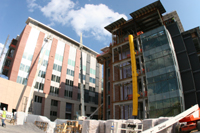|
|
|

|
When bad weather comes, preparation is key
|
By Cindy Abole
Public Relations
When Hurricane Hugo ripped through the Lowcountry more than 21 years
ago, the Charleston area felt the effects of wind gusts of up to 140
mph, driving rain and five-foot tidal surges that led to the evacuation
of more than 120,000 people.
MUSC’s campus sustained more than $33 million in damage that flooded
buildings, disabled equipment and property.
More than two decades later, MUSC’s campus has recovered and thrived,
while construction inspectors and project managers have learned and
taken valuable lessons from these events. MUSC’s skyline has grown and
is now dotted with a number of new buildings and facilities reflecting
progress. At the Drug Discovery and Bioengineering building
construction site, work crews are operating business-as-usual so far
this hurricane season thanks to early preparation, collaborative
planning and new technology.
“Our goal is early preparation and effective communications as a way to
minimize any potential for damage,” said Wade Gatlin, project manager
and architect with MUSC Engineering and Facilities. “All of the
building components work together to prevent intrusion of the elements;
so until the buildings are totally enclosed, they are highly vulnerable
to storm damage.”
 During
hurricane season, lead contractor Brasfield and Gorrie collaborate with
MUSC departments to provide a safe enviroment before and after a storm.
MUSC’s Drug Discovery and Bioengineering building project is expected
to be completed in late 2011. During
hurricane season, lead contractor Brasfield and Gorrie collaborate with
MUSC departments to provide a safe enviroment before and after a storm.
MUSC’s Drug Discovery and Bioengineering building project is expected
to be completed in late 2011.
Gatlin is part of
a hurricane action team that works closely with lead project
construction company, Brasfield and Gorrie, LLC, and their hurricane
officer Justin Rannick, Brasfield and Gorrie’s on-site senior project
manager. “We’re all holding our breaths and crossing our fingers until
hurricane season is over” Gatlin said.
Charleston and coastal South Carolina follow the Atlantic hurricane
season, June 1 through Nov. 30.
According to Gatlin and Rannick, preparation is key from the time
architects draw the plans to the start of construction and events
throughout the project’s timeline. All new construction is governed by
the International Building Code, according to Gatlin. MUSC’s Drug
Discovery and Bioengineering buildings are designed and constructed to
withstand 130 mph wind gusts. Structural engineers also designed the
buildings to sustain lateral loads caused by hurricanes and
earthquakes. Both buildings must meet additional and stringent code
requirements due to the importance the building code places upon
laboratory buildings.
“Wind forces act unevenly across a building’s surface,” explained
Gatlin. “The greatest force occurs at the corners and roof level, so
windows and roofing have to be designed for the maximum wind forces
exerted on the building.”
It is Rannick’s and the Brasfield and Gorrie Hurricane Action team’s
job to monitor weather and any hurricane or severe weather (50 mph or
more) advisories announced by the National Weather Service. The team
meets each week to discuss project safety and review action plans as
part of project readiness.
Rannick and his team follow their company’s own five-level alert system
and hurricane emergency action plan (HEAP) during a weather emergency.
HEAP is part of the company’s safety policy adopted for projects on the
southeastern coast. At the start of each project, the hurricane officer
and project safety partner sit down and review and adaptthe plan to the
scope and timeline of the project.
The plan is activated about three days in advance of a hurricane
warning. That’s when project inspection teams prepare and secure the
construction site. Within 48-to-24 hours of warning, work crews board
windows, remove debris and document the project’s status. Within 12
hours of a storm, the site is secured and workers are evacuated until
an “all clear” signal is announced and a return-to-work notice is
issued by the hurricane officer. After the storm, hurricane teams
inspect and secure the construction site and conduct follow up.
“Much of what we do and how we respond is really no different than what
an individual or single family can do with their own preparations. My
best advice to individuals and families is to communicate, create a
plan early and stick to it,” said Gatlin.
Templates for the MUSC’s research community for organizing hurricane
preparedness plans may be downloaded at
http://academicdepartments.musc.edu/vpfa/operations/Risk%20Management/weather/index.html.
Friday, Oct. 22, 2010
|
|
|



